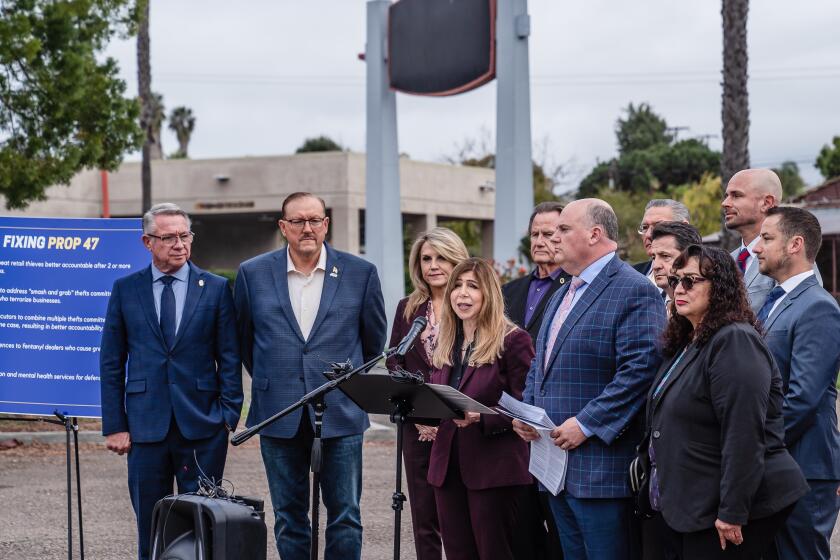Cyclists faulted most in bike-car crashes
When a state law in September required drivers to stay 3 feet from bicyclists while passing, a heated debate erupted over sharing the road, namely whether it was motorists or cyclists who were most to blame for crashes between cars and bikes.
The Three Feet For Safety Act’s author and cycling enthusiasts had argued bicyclists were too often victims of overly aggressive drivers buzzing by. Others responded to the news by recounting times they’d seen a cyclist whiz through a stop sign.
According to the 2,515 accident reports on crashes between cyclists and motorists resulting in the injury or death of a bicyclist in San Diego County from 2011 to September 2014, it was the cyclist who was most often found at fault, when fault was determined.
In 2011, officers determined fault in 701 crashes between a bicyclist and a motorist in which a cyclist was hurt or killed, according to the reports, submitted to California’s Statewide Integrated Traffic Records System. Cyclists were found to be the party most at fault in 390 of those crashes — or 56 percent of the time, the records show.
In 2012, bicyclists shouldered most of the blame 60 percent of the time. Cyclists were said to be most at fault 56 percent of the time in 2013, and, in crashes reported through September this year, were blamed 57 percent of the time.
San Diego police traffic Lt. Leonard Flake said that in 28 years as an officer who deals with crashes, he found it was the cyclist who was at fault a majority of the time.
“Many of those cases were violations of right of way, where the bicyclist cut in front of a car or decided not to stop at a stop sign or a red light — just rode right through it,” Flake said.
Bicycling advocates argue that deciding who’s to blame is a more complicated issue than crash reports make it out to be, and that focusing on fault overshadows a more troubling statistic: the sheer number of bicyclists being injured on shared roadways.
Hundreds of bicyclists were injured across the county from 2011 to Sept. 2014. Of the 2,515 crashes analyzed, 27 bicyclists were killed.
Police note that just because one person in a crash was found more to blame doesn’t mean the other party was blameless. For example, a motorist’s speed could have contributed to an accident, though a bicyclist who ran a red light might be found more at fault.
Only crashes between bicyclists and motorists in which a cyclist was injured or killed were included in the 2,515 accident reports from 2011-Sept. 2014. Solo bicycle crashes, collisions between cyclists, crashes between cyclists and pedestrians or crashes in which fault wasn’t determined were excluded. Those types of collisions accounted for 30 percent of 3,767 bicyclist crashes.
Samantha Ollinger, executive director of BikeSD, said the findings of blame mask the multifaceted challenge of safely sharing roadways in a city that is automobile-centric.
“It seems a little far-fetched to state that there is this whole issue about safety and a majority of people at fault are cyclists, when the driving public is a much, much greater percentage of San Diego than any other road user,” she said.
Ollinger’s organization advocates for safe — and separate — spaces for cycling and walking in San Diego, hoping to get more people to venture out from behind the wheel. It works to redesign existing street networks to better protect cyclists and pedestrians.
Sharing the road with 2-ton vehicles isn’t the safest setup, she said.
“People are making mistakes, sometimes they’re even breaking the law,” Ollinger said. “And the solution ought to be how do we create a system where even when you make a mistake, you’re not going to pay for it with your life, or a serious injury.”
Kathleen Ferrier, the policy manager for Circulate San Diego, said her organization is looking at some statistics of its own. According to the National Household Travel Survey, while only 1 percent of people get around by bicycle, bicyclists account for 10 percent of U.S. traffic fatalities.
“Looking at these percentages shows a disparity that exists between how people are getting around and who is getting hurt,” Ferrier said.
Both Ollinger and Ferrier also worry that officers deciding blame might be biased in favor of motorists.
BikeSD has taken a keen interest in a number of cases in which it seemed a driver should have faced charges in the death or injury of a cyclist, but didn’t.
In 2012, David Ortiz, 29, of Pacific Beach was riding to work on Balboa Avenue when, according to the organization’s website, he was hit from behind by a Ford Expedition. Ortiz was thrown from his bicycle and fatally struck by two vehicles.
The site quotes a San Diego police lieutenant who said both the driver and the rider shared responsibility in the crash. “Investigators, however, have never provided a reasonable explanation how (the cyclist), struck from behind, shares responsibility for his own death,” the BikeSD website said.
According to state crash records, fault wasn’t determined in the crash. BikeSD’s website said no charges were filed against the driver.
In another case, 64-year-old Marjie Barnes-Grant was biking home along Campo Road in Spring Valley in 2013 when a Toyota Land Cruiser struck her. The 56-year-old driver told police he fell asleep at the wheel and didn’t wake up until he hit a tree.
The driver said he got a ride home from a friend without realizing he had hit a bicyclist, and only knew about the collision when his friend returned to the crash site and told him about the injured cyclist.
It was later determined the driver had no insurance, was driving on a suspended license, and had admitted to drinking beforehand. He told officers he wasn’t drunk, and, after a field sobriety test, the officer agreed.
The injured bicyclist suffered several broken bones and underwent at least two surgeries. The driver was identified as the party at fault, according to state crash records. BikeSD’s site said he wasn’t charged.
Lt. Flake said that while officers occasionally can’t pin fault in a collision, they usually can.
Fault was not determined in only about 6 percent of the 2011-Sept. 2014 crashes with motorists, according to state records.
“It can be difficult, but generally speaking, a reasonably seasoned investigator is going to be able to look at a scenario and — based on statements from involved parties, evidence, their training and experience — arrive at an outcome supported by all of those things,” Flake said.
The lieutenant acknowledged that many of San Diego’s streets weren’t designed with bicyclists in mind, and said his department is often looking at ways to make streets safer, through engineering, education and enforcement.
But the roadways will never be perfect, he said, and that’s a fact everyone on the road, but especially more vulnerable users like bicyclists, need to keep in mind.
“As a bicycle rider, you may be very accomplished. You know the streets. You take that route every day, but you still have to be vigilant,” he said. “That means looking several steps down the road. That needs to be a part of your psyche. ‘What can I do to best ensure my safety?’”
Andy Hanshaw is the executive director of the San Diego County Bicycle Coalition, which promotes safe riding and even offers classes for bicyclists who want to get more familiar with the rules of the road. He and other cycling enthusiasts are looking forward to the city carrying through on its efforts to make streets safer for bikes.
As he sees it, “Bicyclists have the same responsibilities, and the same rights to the road.”
More findings: County bike accidents, 2011-2013
Bicyclists
- Bicyclists between 15 and 19 were most likely to be involved in the 2,014 countywide crashes analyzed from 2011-13, and were those most likely to be found at fault. (17% of all crashes involved 15- to 19-year-olds; and 21% of bicyclists found at fault were 15-19.)
- The gender of the bicyclist involved was not always provided, but males were much more likely to get in a crash (1,645 of 2,014) and to be found at fault (950.)
- Female bicyclists were found at fault 196 times and were involved in crashes 363 times.
Motorists
- The average age of motorists involved in a crash with a bicyclist from 2011-13 was 54, with overall ages ranging from 16 to 95.
- Twenty-year-olds were most likely to get into a crash with a bicyclist, followed by drivers 52, 24, 37 and 28 years old.
- Male drivers got into crashes with cyclists more often then women. Men were involved in bike crashes 1,074 times, while women were 778 times. (The motorists’ gender was not identified in the reports on about 160 crashes.)
- Male drivers were found more at fault 439 times, while female drivers were found more at fault 319 times.


